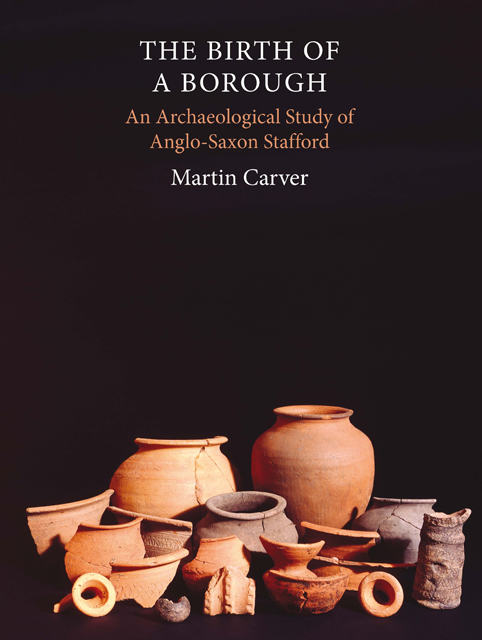Book contents
- Frontmatter
- Contents
- List of Illustrations
- Preface
- Acknowledgements
- Abbreviations
- 1 Questions
- 2 Digging up Stafford: Evaluation and Design
- 3 Seven Windows on Early Stafford: The Principal Investigations
- 4 Æthelflæd’s Town
- 5 Aftermath: Norman and Medieval Stafford
- 6 Anglo-Saxon Stafford in Context
- Digest A1 Archaeological Interventions at Stafford to 1988
- Digest A2 Dendrochronological and Radiocarbon Dates
- Digest A3 Pottery Seriation
- Digest A4 Key to Pottery Illustrations
- Digest A5 Excavated Structures
- Digest A6 Contents of the Stafford Online Archive: http://ads.ahds.ac.uk/catalogue/archive/stafford_eh_2009
- Bibliography
- Index
Digest A3 - Pottery Seriation
Published online by Cambridge University Press: 17 February 2023
- Frontmatter
- Contents
- List of Illustrations
- Preface
- Acknowledgements
- Abbreviations
- 1 Questions
- 2 Digging up Stafford: Evaluation and Design
- 3 Seven Windows on Early Stafford: The Principal Investigations
- 4 Æthelflæd’s Town
- 5 Aftermath: Norman and Medieval Stafford
- 6 Anglo-Saxon Stafford in Context
- Digest A1 Archaeological Interventions at Stafford to 1988
- Digest A2 Dendrochronological and Radiocarbon Dates
- Digest A3 Pottery Seriation
- Digest A4 Key to Pottery Illustrations
- Digest A5 Excavated Structures
- Digest A6 Contents of the Stafford Online Archive: http://ads.ahds.ac.uk/catalogue/archive/stafford_eh_2009
- Bibliography
- Index
Summary
Each of the major excavations for which quantification data existed was independently seriated (St Mary's Grove, Bath Street, Tipping Street (north) and Clarke Street). In each case the best order as determined by stratification formed the Y-axis, and the best order of manufacture of the pottery, as then known, formed the X-axis. The pottery was quantified by Charlotte Cane using EVE (estimated vessel equivalents) expressed as a sum of percentages of the vessel present in a context.
The ordering of the stratification was refined within permitted limits (i.e. where the stratigraphy was unknown or uncertain). The order of manufacture was then improved to produce a less ambiguous or contradictory sequence, the enhancements being argued for in each case (see archive).
The order of pottery manufacture in each of the four seriations was then compared, and a master table prepared. This list of types in chronological order was then reconciled with Deborah Ford's study of the medieval pottery of Staffordshire to produce a concordance between the typology derived by Charlotte Cane and the more general typology resulting from Ford's study.
Since the seriation has been used to refine the arguments for sequence (Chapter 3), given here for reference are the four seriation diagrams and the concordance of pottery types.
Concordance of pottery types
Roman, Late Saxon, medieval and post-medieval pottery was recorded from the Stafford campaign 1975–1985 in large quantities. In general all sherds were recovered by hand and kept from all contexts excavated at recovery level C and finer levels; this means all sherds from all contexts thought to be medieval or earlier on all interventions, plus certain post-medieval contexts at St Mary's Grove where recovery at levels C and D was also applied.
The Roman and Late Saxon types stood out and preliminary studies were made (FR8.2.2 and FR8.2.3). From 1980 Charlotte Cane defined and brought into use a typology for the medieval pottery based on fabrics and forms. The assemblage from ST15 (1975) was later revisited and defined in terms of the new typology. The system used a three-letter code to report the fabric (IWH), denoting, respectively, surface treatment, method of manufacture and hardness.
- Type
- Chapter
- Information
- The Birth of a BoroughAn Archaeological Study of Anglo-Saxon Stafford, pp. 151 - 161Publisher: Boydell & BrewerPrint publication year: 2010



